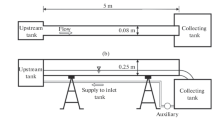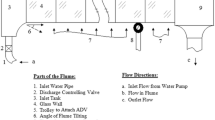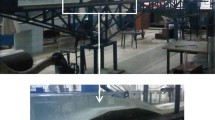Abstract
In this study, the flow characteristics over modified semi-cylindrical weirs (MSCM) were investigated using computational fluid dynamics (CFD) simulations. The simulations included the analysis of flow velocity and pressure distribution, turbulence intensity, and streamline patterns. The numerical results were compared to laboratory observations, and a good agreement was observed. Different turbulence models, including renormalized group (RNG) k-ε, standard k-ε, k-ω two-equations, and large eddy simulation (LES), were evaluated, and all showed suitable performance in simulating the flow field and hydraulic characteristics. However, the standard k-ε model outperformed the other models. The analysis of streamline patterns from upstream to downstream of the weirs showed that the curve of the crest provided an opportunity for the flow to harmonize with the surface of the crest. The downstream ramp guided the streamlines, preventing collision with the downstream slab surface and vorticity formation. Additionally, the results indicated that adding the downstream ramp significantly reduced the turbulence intensity of the flow at the toe of the weirs. The analysis of pressure distribution showed that the flow departed from hydrostatic state when reaching the weir, and the maximum deviation occurred at the crest vertex.






Similar content being viewed by others
Data Availability
All data, models, and code generated or used during the study appear in the submitted article.
Abbreviations
- C S :
-
Smagorinsky coefficient
- d C :
-
Critical depth
- E ij :
-
Mean rate of deformation of an element of the fluid in a turbulent flow
- fs :
-
Surface tension
- g :
-
Gravitational acceleration
- k :
-
Kinetic energy of the turbulent flow
- L :
-
Length of the crest
- L C :
-
Horizontal distance from the crest initial point to the crest vertex
- L E :
-
Horizontal distance from the crest vertex to the crest endpoint
- L S :
-
Length scale
- l :
-
Turbulent length scale
- P:
-
Pressure
- q :
-
Discharge per unit width
- R :
-
Radius of the weir crest
- \(\tilde{S}\) :
-
Strain rate
- \({\tilde{\mathbf{S}}}_{{{\mathbf{ij}}}}\) :
-
Strain-rate tensor
- U :
-
Velocity vector of the flow
- u :
-
Stream-wise velocity
- u c :
-
Critical velocity
- u', v', w' :
-
Velocity fluctuations in x, y, and z directions, respectively
- \(\overline{V}\) :
-
Average velocity
- y :
-
Flow depth
- α * :
-
A coefficient used to damp the turbulent viscosity
- Δ:
-
3D gradient operator
- δx, δy, δz :
-
Grid cell dimensions in the x, y, and z directions, respectively
- ε :
-
Rate of dissipation of turbulent kinetic energy
- θ :
-
Slope of a downstream ramp of the crest
- μ :
-
Fluid viscosity
- μ t :
-
Turbulent viscosity
- μ t0 :
-
Turbulent viscosity without the swirl modification
- ν t :
-
Kinematic eddy viscosity
- ρ :
-
Density of the fluid
- σ :
-
Surface tension
- τ :
-
Tensor of the viscous stress
- Ω:
-
Characteristic swirl number
- ω :
-
Specific rate of dissipation of the turbulence kinetic energy into internal thermal energy
References
Abhash A, Pandey KK (2021) Experimental and numerical study of discharge capacity and sediment profile upstream of piano key weirs with different plan geometries. Water Resour Manag 35:1529–1546
Akoz MS, Gumus V, Kirkgoz MS (2014) Numerical simulation of flow over a semicylinder weir. J Irrig Drain Eng 140:4014016
Aydin MC (2012) CFD simulation of free-surface flow over triangular labyrinth side weir. Adv Eng Softw 45:159–166
Bagheri S, Heidarpour M (2010) Overflow characteristics of circular-crested weirs. J Hydraul Res 48:515–520
Bagheri S, Kabiri-Samani A (2020) Overflow characteristics of streamlined weirs based on model experimentation. Flow Meas Instrum 73:101720
Behroozi AM, Vaghefi M (2022) Experimental and numerical study of the effect of zigzag crests with various geometries on the performance of A-type piano key weirs. Water Resour Manag 36:4517–4533
Castro-Orgaz O (2008) Curvilinear flow over round-crested weirs. J Hydraul Res 46:543–547
Castro-Orgaz O, Giráldez JV, Ayuso JL (2008) Critical flow over circular crested weirs. J Hydraul Eng 134:1661–1664
Chanson H (2004) Hydraulics of open channel flow. Elsevier
Choudhury D (1993) Introduction to Renormalisation Group Method and Turbulence Modelling, 107, Fluent. Inc. Technical Memorandum TM
Deardorff JW (1970) A three-dimensional numerical study of turbulent channel flow at large Reynolds numbers. J Fluid Mech 41:453–480
Guan D, Melville BW, Friedrich H (2014) Flow patterns and turbulence structures in a scour hole downstream of a submerged weir. J Hydraul Eng 140:68–76
Haghiabi AH, Mohammadzadeh-Habili J, Parsaie A (2018) Development of an evaluation method for velocity distribution over cylindrical weirs using doublet concept. Flow Meas Instrum 61:79–83
Kartal V, Emiroglu ME (2023) Hydraulic performance of sharp-crested side slit weirs. Water Resour Manag 1–23
Launder BE, Spalding DB (1972) Lectures in mathematical models of turbulence. Academic Press, London
Mohammadzadeh-Habili J, Heidarpour M, Haghiabi A (2016) Comparison the hydraulic characteristics of finite crest length weir with quarter-circular crested weir. Flow Meas Instrum 52:77–82
Parsaie A, Haghiabi AH (2019) The hydraulic investigation of circular crested stepped spillway. Flow Meas Instrum 70:101624
Parsaie A, Shareef SJS, Haghiabi AH et al (2022) Numerical simulation of flow on circular crested stepped spillway. Appl Water Sci 12:215
Ramamurthy AS, Vo N-D (1993) Characteristics of circular-crested weir. J Hydraul Eng 119:1055–1062
Roy S, Barman K, Das VK et al (2020) Experimental investigation of undercut mechanisms of river bank erosion based on 3D turbulence characteristics. Environ Process 7:341–366
Schmocker L, Halldórsdóttir BR, Hager WH (2011) Effect of weir face angles on circular-crested weir flow. J Hydraul Eng 137:637–643
Versteeg HK, Malalasekera W (2007) An introduction to computational fluid dynamics: the finite volume method. Second ed. Pearson/Prentice Hall, Harlow, England
Watkins S, Saunders JW, Hoffmann PH (1995) Turbulence experienced by moving vehicles. Part I. Introduction and turbulence intensity. J Wind Eng Ind Aerodyn 57:1–17. https://doi.org/10.1016/0167-6105(94)00100-R
Wilcox DC (1998) Turbulence modeling for CFD. DCW industries La Canada, CA
Acknowledgements
We are grateful to the Research Council of Shahid Chamran University of Ahvaz for financial support (SCU.WH1401.72091).
Author information
Authors and Affiliations
Corresponding author
Ethics declarations
Conflict of Interest
All authors declare no conflict of interest.
Additional information
Publisher's Note
Springer Nature remains neutral with regard to jurisdictional claims in published maps and institutional affiliations.
Rights and permissions
Springer Nature or its licensor (e.g. a society or other partner) holds exclusive rights to this article under a publishing agreement with the author(s) or other rightsholder(s); author self-archiving of the accepted manuscript version of this article is solely governed by the terms of such publishing agreement and applicable law.
About this article
Cite this article
Afaridegan, E., Amanian, N., Haghiabi, A. et al. Numerical Investigation of Modified Semi-Cylindrical Weirs. Water Resour Manage 37, 3715–3728 (2023). https://doi.org/10.1007/s11269-023-03523-y
Received:
Accepted:
Published:
Issue Date:
DOI: https://doi.org/10.1007/s11269-023-03523-y




